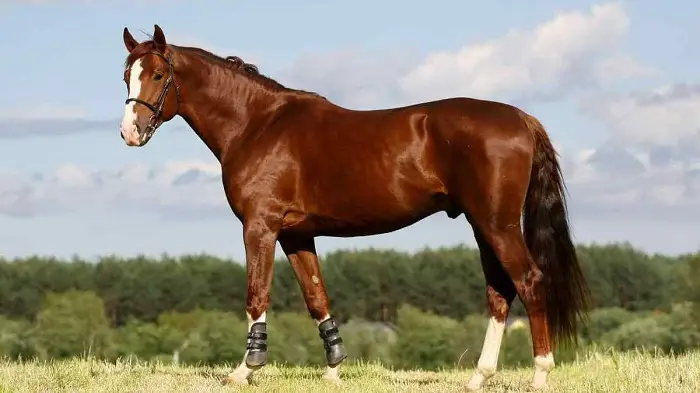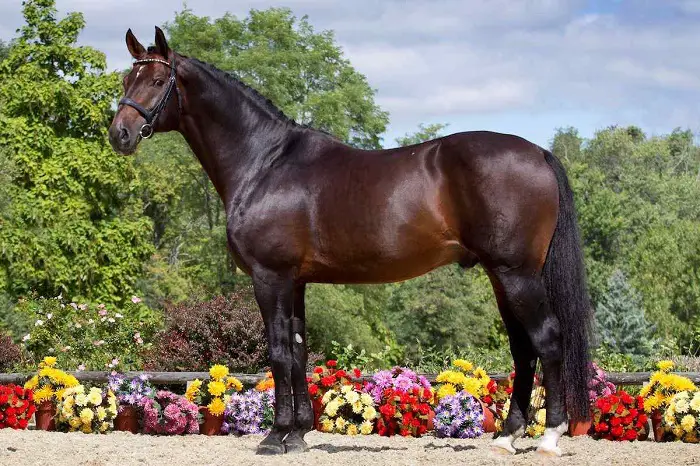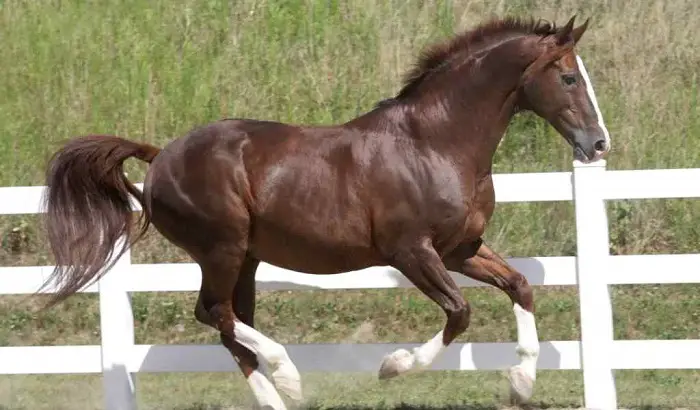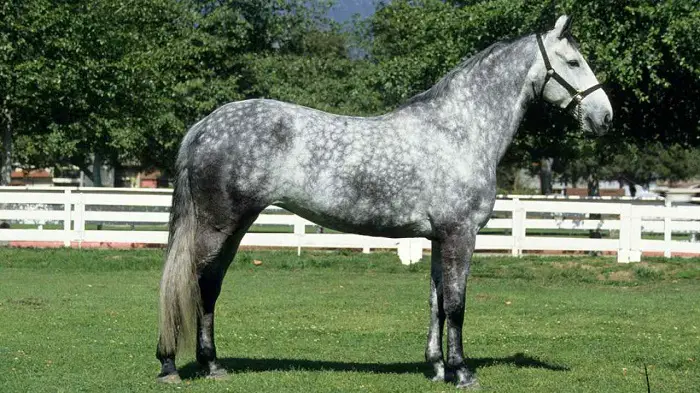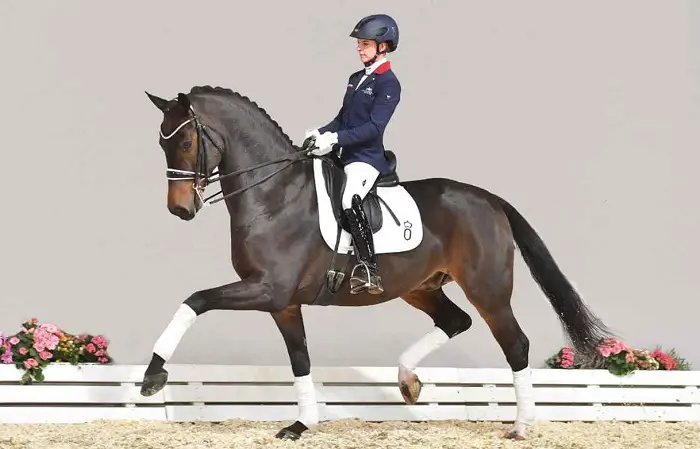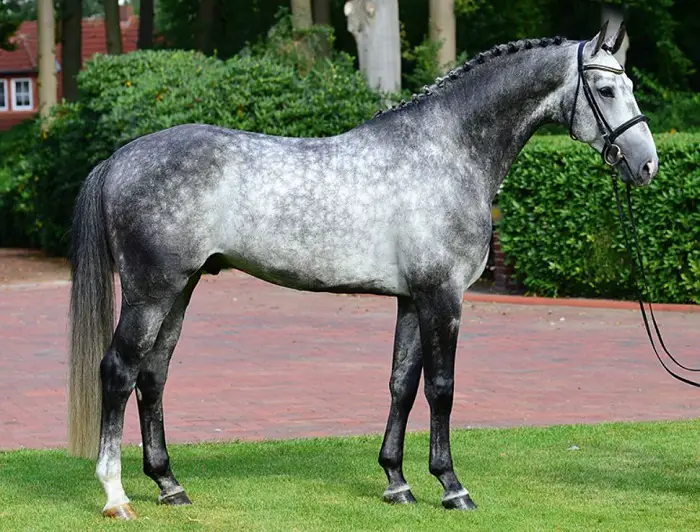The Oldenburg Horse is a warmblood horse breed that originated in the region of Oldenburg in northern Germany. The breed is known for its athleticism, strength, and elegance, and is highly valued for dressage, show jumping, and eventing.
Origin and History of Oldenburg Horse
The Oldenburger breed originated in the region of Oldenburg in northern Germany, where the Counts of Oldenburg began breeding horses for use in agriculture and transportation in the 1600s. The horses were initially bred for their strength, endurance, and ability to perform heavy work.
In the 1800s, Thoroughbred blood was introduced to the breed to improve its athleticism and speed. The Oldenburgs were crossed with Thoroughbreds and other breeds, such as Hanoverians and Neapolitans, to create a horse that was not only strong and durable but also fast and agile.
During the 19th century, the military widely used Oldenburger bred to create a superior cavalry horse. The breed also became popular with the nobility and wealthy landowners, who used them for hunting and carriage driving.
In the early 20th century, the Oldenburger Breeders’ Society was established in Germany to preserve and improve the breed. The horse society set out to create a horse that was not only athletic but also elegant and refined, with a balanced and harmonious conformation.
Physical Features of Oldenburg Horse
The Oldenburger is a warm-blood breed known for its strength, athleticism, and elegance. Here are some of the physical features of the Oldenburg Horse:
- Body: Oldenburgs have a robust build with a deep, broad chest, well-sprung ribs, and a strong, muscular back. They have long, sloping shoulder that allows for a long stride and fluid movement. Their croup is typically slightly sloped and muscular, which provides power and impulsion.
- Head and Neck: The head of an Oldenburg is refined with a straight or slightly convex profile. The neck is long and elegant, with a pronounced arch and a well-defined nape.
- Legs: Oldenburgs have strong, well-proportioned legs, clean joints, and large, well-formed hooves. Their legs are set well under their bodies, which helps them to maintain balance and stability during fast movements and high jumps.
- Coat: Oldenburgs have a range of coat colors, including black, brown, bay, chestnut, and gray. They may also have white markings on their faces and legs.
- Movement: Oldenburgs are known for their smooth and fluid movement, with an extended trot that covers a lot of ground. They have a natural ability for collected and expressive gaits, which makes them ideal for dressage.
Height and Weight of Oldenburg Horse
Oldenburg horses are a warmblood breed that typically stands between 16 and 17 hands high (64 to 68 inches) at the shoulder. The weight of an Oldenburger can vary depending on the individual’s height, build, and fitness level, but they generally weigh between 1200 and 1500 pounds (550 to 680 kg).
Color and Markings of Oldenburg Horse
Oldenburg horses can come in various colors: black, brown, bay, chestnut, and gray. They may also have white markings on their faces and legs. Standard facial markings include blazes, stars, and snips. Leg markings can range from tiny socks to full stockings, and some horses may also have white markings on their bellies or chests.
The Oldenburg breed registry allows for a wide range of colors and markings, but solid colors are preferred over patterns or spots. While uncommon, some Oldenburgs may have pinto or appaloosa patterns due to the influence of other breeds in their lineage.
The behavior of Oldenburg Horse
Oldenburgers are known for their calm, kind, and willing temperament, making them popular for riders of all levels. They are generally easy to handle and work with and have a natural desire to please their riders.
Oldenburgs are intelligent and quick to learn, making them ideal for training in various equestrian disciplines. They have a natural athleticism and grace, which allows them to excel in dressage, show jumping, and eventing.
Oldenburgers are typically social animals and enjoy the company of other horses. They do well in herd environments and may become anxious or stressed alone. Proper socialization and regular exercise are essential to keeping Oldenburg horses happy and healthy.
While Oldenburgs are generally easy-going and well-behaved, like all horses, they can become frightened or agitated in certain situations. It is essential for riders to develop a strong bond of trust and respect with their horses and to provide them with a safe and secure environment to minimize the risk of accidents or injuries. With proper care and attention, Oldenburg horses can make excellent companions and competitive partners for riders of all levels.
Feed and Nutrition of Oldenburg
Proper nutrition is essential for the health and well-being of Oldenburg horses. Here are some guidelines for feeding and nutrition:
- Forage: The foundation of an Oldenburg’s diet should be high-quality forage, such as grass or hay. Horses should have access to forage throughout the day to promote healthy digestion and reduce the risk of digestive issues.
- Concentrates: Oldenburgs in moderate to heavy work may require additional calories and nutrients in the form of concentrates, such as grain or pellets. Choosing a concentrate appropriate for the horse’s age, weight, and level of activity is essential.
- Protein: Oldenburgs require a balanced protein intake to support muscle development and repair. Good sources of protein include alfalfa, soybean meal, and grass hay.
- Vitamins and Minerals: Horses require a variety of vitamins and minerals for optimal health, including vitamin E, selenium, and copper. A balanced commercial feed or supplement can help meet the horse’s nutritional needs.
- Water: Access to fresh water is essential for proper hydration and for preventing digestive issues. Horses should have access to water at all times.
Health and Care of Warmblood Oldenburg
Here are some guidelines for maintaining the health and well-being of an Oldenburger:
- Regular Veterinary Care: Oldenburgs require regular veterinary checkups to ensure that they are in good health. Vaccinations, deworming, and dental care are essential components of routine health care.
- Exercise: Regular exercise is essential for keeping Oldenburgs fit and healthy. The amount and type of exercise will depend on the horse’s age, fitness level, and activity level.
- Hoof Care: Regular hoof care, including trimming and shoeing, is essential for maintaining the health of the horse’s feet. Horses should have their hooves trimmed every 6-8 weeks or as a farrier recommends.
- Nutrition: A balanced diet that meets the horse’s nutritional needs is essential for good health. Horses should always have access to clean, fresh water, and their feed should be free from mold and other contaminants.
- Shelter: Oldenburgs should have access to shelter to protect them from extreme weather conditions. Stalls should be kept clean and well-ventilated, and horses should have access to a clean and dry area for lying down.
- Grooming: Regular grooming, including brushing, bathing, and mane and tail care, is essential for maintaining the horse’s skin and coat health. Grooming also allows checking for any cuts, scrapes, or other signs of injury or illness.
By providing proper care and attention, Oldenburg horses can live long and healthy lives and make excellent riding companions for their owners.
Special features of Oldenburg Horse
Oldenburgers are known for several unique features, including:
- Athleticism: Oldenburgs are renowned for their natural athleticism and grace. They have a powerful and elegant appearance and are known for their ability to excel in dressage, show jumping, and eventing.
- Versatility: Oldenburgs are versatile horses that are well-suited for a variety of equestrian disciplines. They have a calm and willing temperament and are often used as riding horses for riders of all levels.
- Pedigree: The Oldenburg breed has a long and rich history, and the breed registry is known for its strict breeding standards. Oldenburg horses are carefully bred for their athleticism, temperament, and conformation and are often highly sought after by riders and breeders worldwide.
- Size: Oldenburg horses are typically large, with a height range of 16 to 17.2 hands. Their strong and muscular build contributes to their natural athleticism and power.
- Temperament: Oldenburg horses are known for their calm, kind, and willing temperament. They are often easy to handle and work with and natural desire to please their riders.
Uses of Oldenburg Horse
Oldenburg horses are versatile and are often used for a variety of equestrian disciplines, including:
- Dressage: Oldenburg horses are known for their natural athleticism and grace, which makes them well-suited for dressage. They are willing to learn and have a calm temperament, making them a popular choice among dressage riders.
- Show Jumping: Oldenburgs have a robust and muscular build, which makes them well-suited for show jumping. They have a natural ability to clear jumps and are often used in international show jumping competitions.
- Eventing: Oldenburgs are versatile horses that can excel in all three phases of eventing – dressage, cross-country, and show jumping. They have the stamina and athleticism needed to complete a demanding cross-country course and the precision and grace needed for dressage and show jumping.
- Hunter: Oldenburg horses are also used for hunter competitions, which test the horse’s ability to jump over a series of obstacles while maintaining a steady pace and rhythm.
- Pleasure Riding: Oldenburg horses have a calm and willing temperament, which makes them a popular choice for pleasure riding. They are often used as trail horses or for leisurely rides around the countryside.
Concluding Remarks on Oldenburg Horse
In conclusion, the Oldenburg horse is a versatile and athletic breed with a rich history and a reputation for excellence. With their robust build, calm temperament, and willingness to please, they are well-suited for various equestrian disciplines, including dressage, show jumping, eventing, and pleasure riding.
Oldenburgs are known for their pedigree and strict breeding standards, resulting in a breed that excels in performance and conformation. Their versatility and athleticism have made them a popular choice among riders of all levels, and they are often sought after by breeders and competitors worldwide.
If you consider an Oldenburg horse a riding or breeding companion, it is essential to provide them with proper care and attention to maintain their health and well-being. Regular veterinary care, exercise, nutrition, shelter, and grooming are all essential to caring for an Oldenburg horse.
Overall, the Oldenburger is a remarkable breed with a bright future in equestrian sports and leisure riding.
